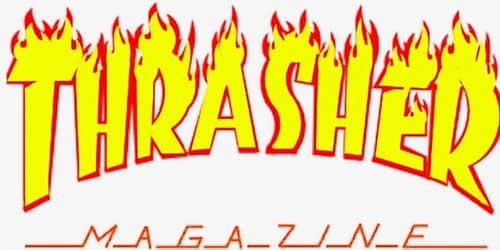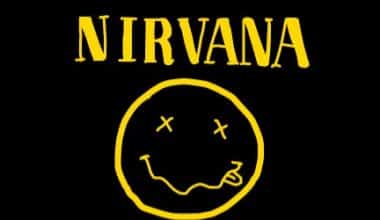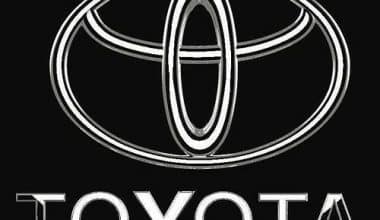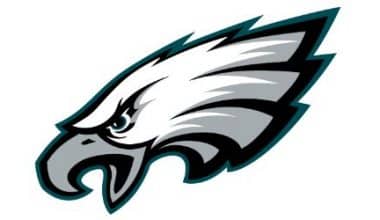Thrasher is a monthly magazine that skateboarders all over the world read and enjoy. In 1981, co-founders Fausto Vitello and Eric Swenson saw an ad for the Independent Truck Company in a magazine. This is where they got the idea for the company. Learn more about the Atlanta Thrasher Magazine logo in this.
Overview Of the Thrasher Logo
In January 1981, Eric Swenson and Fausto Vitello started a magazine about skateboarding called Thrasher. This magazine is about skateboarding and music in general. It has articles, photos, interviews, and reviews of skateparks.
The magazine also has a website, a YouTube channel, and user-accessible features like “Firing Line,” “Hall of Meat,” an online store, a video library, a radio show, and a discussion forum. The company owns and runs both 66 6th, a skate shop in San Francisco, and Double Rock, an indoor skateboarding center.
An old favorite is Thrasher, a magazine about skateboarding. Since they opened in 1981, they have been a haven for skateboarders. This magazine is as rough as it is helpful, and skateboarders have been reading it for years, with open arms, as long as you don’t mall-grab it. High-Speed Productions publishes Thrasher magazine and about 250,000 people read it now.
About the Thrasher Logo
People in the skateboarding subculture have called Thrasher magazine the “Bible.” Today, if you wear something with the Thrasher logo on it, it doesn’t mean you’re a skater, but it does mean you respect and value the skateboarding community.
The magazine’s iconic flame logo made its debut at the inauguration of Thrasher. In January 1981, Eric Swenson and Fausto Vitello started the magazine Thrasher in San Francisco. Many people in the skating subculture think of it as the Bible.
According to the urban dictionary, the 1980s were a time when a good skater was called a “thrasher.” Thrasher was made so that skateboarders could share their creative ideas with the public. Skateboarding is a part of a subculture in California. Some people have said that the magazine is about the countercultural skateboarding scene in California.
Eric Swenson and Fausto Vitello, two businessmen, started Thrasher in 1981 to promote their company, Independent Trucks, which made parts for skateboarders. Since then, Thrasher has become the best place to get news, reviews, and interviews about skateboarding. This is because almost everyone who works there is a skateboarder.
It has been around the longest and is the most-read magazine for skaters. Because of its important role in the subculture, it has been called “The Bible.” Even though the magazine didn’t like how popular its merchandise was with off-duty models and celebrities in the middle of the 2000s, it has stayed true to its roots by putting high-quality skateboarding content ahead of celebrity endorsements and collaborations and keeping the brazen and fiery tone of its motto, “skate and destroy.”
1978
Richard Novak, Jay Shiurman, Eric Swenson, and Fausto Vitello start the Independent Truck Company with the goal of making a high-quality skateboard truck.
1983
Thrasher’s first compilation album is called Skate Rock, and it has a bunch of California punk bands with skateboarders as lead singers. There are six more books in the series, and the magazine is where you can buy them all.
1990-2011
Thrasher’s first skateboarder of the year was Tony Hawk. For the first time, the Thrasher King of the Road Skateboarding Contest was held. Over the course of two weeks, a group of invited teams of professional skaters will compete in a series of challenges all over the United States for the chance to win prizes.
Since then, the competition has been held every year except for 2008 and 2009. The winning team will not only get bragging rights and money, but they will also be on the cover of Thrasher. Thrasher and Supreme’s first project together hits the ground running.
2016
When the flame logo became popular, it started a war of knock-offs and bootleg versions, which Thrasher called out in the open, naming offending retailers like H&M and Forever 21.
2017
Thrasher and Vans worked together to make the Red Hot collection, which has the now-iconic flame logo. However, Thrasher, on the other hand, shows off new collaborations with brands like Beams and Beauty & Youth, as well as a pop-art capsule collection with Supreme. Thrasher teams up with Dutch artist Parra to create a new version of their own knockoff design that stands out from the crowd.
2019
In honor of the brand’s 25th anniversary, there are more and more rumors that Supreme will make new products with other brands.
Thrasher Magazine
The title and spelling of the book convey all of these ideas. To create the Thrasher logo, the word “THRASHER” is written in various punk rock-style fonts. A flaming arch surrounds the words.
The letters have orange and red lines around them. Also, as the flames get stronger, their color changes from yellow to orange to red. The word is written with a slant and in bold. As the saying goes, it’s all capital letters.
Fausto Vitello and Eric Swenson started Thrasher in 1981 as a way to get the word out about their company, Independent Truck Company, which made trucks for skateboards. Thatcher was the first editor of the magazine. Around the middle of 1981, Mofo became the second member of Thatcher’s staff.
In 1993, Jake Phelps became the editor of the newspaper. Through his work as a photojournalist, he showed the world the punk-skater ethic. He also changed the style of the magazine, which led to the rise of a new subculture in skateboarding. However, the magazine had to support a PlayStation game called Thrasher Presents Skate and Destroy in 1999. Tony Vitello took over as magazine owner after Vitello and Swenson died. Vitello died of a heart attack in 2006, and Swenson killed himself in 2011. Jake Phelps, a long-time editor, died on March 14, 2019. Michael Burnett, who runs a magazine, is a photographer.
Its Background
Eric Swenson and Fausto Vitello, two businessmen, started Thrasher in 1981 to promote their company, Independent Trucks, which made parts for skateboarders. Since then, Thrasher has become the best place to get news, reviews, and interviews about skateboarding. This is because almost everyone who works there is a skateboarder.
It has been around the longest and is the most-read magazine for skaters. Because of its important role in the subculture, it has been called “The Bible.” Even though the magazine didn’t like how popular its merchandise was with off-duty models and celebrities in the 2000s, it has stayed true to its roots by putting high-quality skateboarding content ahead of celebrity endorsements and collaborations and keeping the brazen and fiery tone of its motto, “skate and destroy.”
1981-today
The first issue of the magazine came out in early 1981. In San Francisco, it was printed for the first time. After being on the cover of a Bob Marley album, Banco became linked to the Caribbean and reggae. However, these ideas were probably important to the people who started the magazine and are at the heart of what it wants to do.
After a while, the magazine became an important part of the skate scene on the West Coast. As a result, they forgot the “reggae” roots and it became the primary font of the country’s skate culture.
Symbol
The wordmark was the inspiration for the logo design. It has a big, slanted font that says “Thrasher” on it. The tops of the letters are surrounded by stylized flames of fire. Under the logo, the word “magazine” is written in smaller caps.
Emblem Versions
There are both old and new versions of the Thrasher logo. There is both an emblem that burns and a version that doesn’t. Most websites and magazines use the version without the flames.
There are different forms of the symbol. The website and magazine cover both feature a toned-down version of the “burning” logo. You can find the “burning” logo on a variety of brand products. It comes in different colors, like black, white, and red.
Font
Instead of the title, the cover shows the publication’s logo. Because the letters on the outside of “THRASHER” are longer than the ones in the middle, the arch is very noticeable. The most popular style is one with fiery graphics, but there are also other kinds. The fiery word was on the front cover of the magazine, as well as on T-shirts and other swag.
When everyone knew about Thrasher’s famous logo, it stopped being important to skateboarders. Many famous people have taken on the image of skateboarders, even though some of them have never even been on one. The magazine’s writers got into a fight with fashion victims, harshly criticized Vogue, and made fun of people who blindly follow the Thrasher style. They eventually gave up because the logo was no longer in contact with true skate culture and had instead become a status symbol.
The font in the THRASHER is Banco, which was created by the typographer, graphic designer, and illustrator Roger Excoffon in 1951. The Fonderie Olive foundry made metal letters in this typeface for use in bookstores, butcher shops, and other places thought to be “out of style.” Then, musician Bob Marley used Banco in the reggae style, and Thrasher magazine briefly used the font after Marley passed the torch.
More Information
This is referred to as a “banco.” Roger Excoffon, a French graphic artist, created it in 1951. Until Bob Marley made it popular, the typeface was mostly used in “uncool” places like butcher shops and bookstores.
The logo uses Roger Excoffon’s 1951 Banco typeface, which made its debut in Thrasher in 1981. People also often think of the Caribbean and reggae music when they see this typeface.
Since the words in the logo look like flames, many people think that the company works in the fire industry. They chose this style because the logo represents liberty, defiance, and perseverance. It’s also a sign of being proud of where you live. People who wear this symbol on their clothes are as much a part of the counterculture as they are of the skateboarding subculture.
The logo for the magazine Thrasher shows the style of skating that the magazine promotes, which is raw and uncut.
Colors
The main logo for Thrasher is a mix of yellow, orange, black, and red that looks “fiery.” Since they frequently wordmark on clothing, several variations are possible (neon green and blue, for instance). The traditional logo is black and yellow. The fiery version has many more colors, from yellow and black to crimson and orange.
Its Site
On the magazine’s website, users can hold online discussions in a forum. They can also add new episodes of segments regularly. Some segments:
- “Burnout” is a long-term photo blog run by Michael Burnett, a senior staff photographer
- Rock and Roll
- The “Forefront”
- The Hall of Meat (Video segments featuring “outtakes” of skateboarders injuring themselves while they attempt to perform tricks.)
- “Skateline,” which Gary Rogers showed (hosted by Gary Rogers)
- Bru-Ray (some tour cuts from P-Stone of Thrasher’s movies).
- The designer of the Authentic logo and And1 apparel made the “Brand Evolution” design for some goods.
Majesty Highway
Thrasher won the KOTR (King of the Road) contest for skateboarding in 2003. Professional skaters on teams face off against each other by completing a set of challenges from a booklet. You will get points for each task you finish. Teams compete by doing as many challenges as they can find all over the United States during the same two-week period. In 2011, Thrasher and Converse held a contest in China. The four biggest skateboard deck companies in China took part. KOTR has happened every year without fail until 2018, except in 2008 and 2009
King of the Road was an original show on Viceland that ran from 2016 to 2018. Vice did not renew the show for a fourth season after Jake Phelps died in 2019, according to Michael Burnett, editor-in-chief of Thrasher. In an interview published in April 2020, Burnett said that the show would return in a different format later that year.
Skate Rock
Thrasher has put out a number of compilation albums on the High-Speed Productions label under the name “Skate Rock.” Skate Rock was created by Mofo. The first book in the series came out in 1983, and the last one came out in 1990.
The majority of the bands in the series feature well-known skateboarders such as Steve Caballero, Tony Alva, Bob Denike, Brian Brannon, Mofo, Pushead, Chuck Treece, and Claus Grabke. The first seven issues of Skate Rock were only available on tape and could only be found in the magazine. Some books became vinyl records. Thrasher has done global Skate Rock tours.
Things You Should Know About the Thrasher Logo
His birthday is August 4, 1946, and he was born in San Francisco, California. Fausto Vitello is born in Buenos Aires, Argentina, on August 7, three days later. When Vitello was nine years old, his family had to leave Argentina because of political unrest. They moved to San Francisco, California.
In the 1960s, Swenson and Vitello met each other in the US Army Reserves. They quickly became good friends because they both loved riding motorcycles. Swenson was quiet, sensible, and handy, and had some interest in the design. It was hard to talk to Vitello because he was loud and always said what he thought. They worked well together.
Richard Novak and Jay Shiurman Came up With the Idea for Independent Trucks in 1978
Swenson and Vitello started Thrasher magazine in January 1981. So that people would know about their brand of independent trucks, they decided to start a magazine. They don’t feel like Southern California magazines pay enough attention to them, so they’re looking for a publication in San Francisco to promote their riders and products. They change the name of their printing business to High-Speed Productions, which buys Juxtapoz and Slap in the end.
In a short time, the magazine came to represent a movement that was different from mainstream culture. Raw Skateboarding Magazine was never the most popular or widely read skateboarding magazine, but it did stand for something. The magazine would become a huge success, but neither Vitello nor Swenson would live to see it.
In 2006, Fausto Vitello’s heart stopped while he and some friends were riding their motorcycles. His wife, Gwynn Rose Vitello, is now the president of High-Speed Productions. His daughter is in charge of marketing and sales, and his son, Tony Vitello, is the new editor-in-chief of Thrasher. The same family that started it is still in charge of it.
S.F. In 2011, police found the body of Eric Swenson, who was 64 years old. He killed himself because the pain from an old motorcycle accident was getting too much. He killed himself in front of the police station so that his family wouldn’t have to deal with the pain of finding his body. Both of them had a huge impact on skateboarding, and the sport would be very different without them.
Snowboarding Cover
In its early years, Thrasher covered a wide range of topics that its editors thought were important to the skateboarding community. Skateboarding, music, stories, and even snowboarding were some of the things that were talked about.
Thrasher used to spend a lot of time talking about snowboarding. In one issue, Rob Roskopp is on the cover, riding a snowboard. He has one of Thrasher’s wackiest covers on the board, as well as a sticker from the magazine.
Thrasher Is Worn by Celebrities
Thrasher grew up in the California punk and hardcore scenes, so he is an important part of that group. Back in the 1990s, bands like Sonic Youth and the Beastie Boys would often show up in Thrasher and wear their clothes.
In recent years, a number of famous people who aren’t as “on brand” as Rihanna, Justin Bieber, Tyler the Creator, Ryan Gosling, Bella Thorne, or Adam Levine have worn Thrasher clothes. There are also a lot of other celebrities and models there.
When asked by the press, Phelps said, “We don’t send boxes to Justin Bieber, Rihanna, or any of those fucking clowns.” Vogue published a “skate week” after Thrasher became popular. The skateboarding community hated it because it was poorly written and seemed to try to cash in on how cool skateboarding is. People besides Phelps have said that the mainstream’s attempt to cash in on the skateboard fashion trend is “corny shit.”
Michael Burnett
Michael Burnett was a young person from Texas who went to college in Colorado. Burnett sent Thrasher a zine that Phelps liked, so Thrasher hired him to take photos and write articles. Burnett said in an interview that he taught himself how to use a camera and other tools at work.
For more than 20 years, Burnett’s name has been listed as “Editor at Large,” and Jake Phelps’ name has been listed as “Editor in Chief” on the front page of every issue of Thrasher. So, Burnett did most of the work while Phelps seconded it.
The Recently Successful Reintroduction of Thrasher
In 1981, when the first issue came out, there wasn’t even a skater on the cover. Now, in the year 2020, it is the most-read skateboarding magazine in the world. Skateboarder magazine has been around longer than any other magazine, which is why the skateboarding community calls it “The Bible.”
In 2011, a total of 250,000 people read Thrasher magazine, and the website got an average of 1.5 million unique visitors per month. According to similarweb.com, they get over 2.5 million unique visitors every month, making them the most popular skateboarding website ever.
Thrasher had a relentlessly nasty view of skateboarding. The magazine’s motto was “Skate and Destroy,” and it often asked readers to send in photos of their own broken bones and open wounds.
Thrasher Had a Gametime
“Skate & Destroy” was a video game that came out in 1999. Thrasher and Rockstar made the games. Too bad it came out at the same time as the first Tony Hawk Pro Skater game, which came out only a few months later. Thrasher’s tricks were a little more realistic than, say, Tony Hawk’s Pro Skater, where you could backflip over buildings.
In the game, you can break your board, break a bone, or get arrested. The point was to get a sponsor and get on the cover of Thrasher magazine. The PlayStation version didn’t sell very well, so they had to stop working on the Gameboy Color version.
Awarded Annually to the Best Skater in the World
The most prestigious award in skateboarding is the Thrasher Magazine Skater of the Year (SOTY) Award. An accomplishment that skateboarders are very proud of. In 1990, Tony Hawk was the first skater of the year. Since then, its fame has gone through the roof. It is now the most prestigious award in the sport of skateboarding. Even though the magazine won’t say much about how they chose, most skateboarders believe the rumor that Phelps was in charge of making the final decision.
Skaters Bob Burnquist, Andrew Reynolds, Mark Appleyard, Eric Koston, Arto Saari, Ishod Wair, Bob Burnquit, and Jamie Foy are some other well-known SOTY winners. Skater of the Year (SOTY) has only been won twice by Danny Way and Chris Cole.
Atlanta Thrasher Logo
The Atlanta Thrashers were a team from Atlanta that played in the NHL. On June 25, 1997, Atlanta got a team in the National Hockey League (NHL). The team’s first season was 1999–2000, making it the 28th team in the NHL. They played in the NHL’s Southeast Division of the Eastern Conference, and their home ice was the building in downtown Atlanta that is now called State Farm Arena. The Thrashers won the Southeast Division in 2006–07, which got them into the Stanley Cup playoffs. But the New York Rangers beat them in four games and got rid of them.
In May 2011, the Canadian company True North Sports & Entertainment bought the Thrashers. When the group moved the team to Winnipeg, it became the Winnipeg Jets (the first incarnation of the Winnipeg Jets relocated to Phoenix in 1996 to become the Coyotes). On June 21, 2011, the NHL gave the deal and move their approval. Because the franchise was sold and moved, Atlanta became the first city in the modern history of the National Hockey League to have both of its ice hockey teams leave for other cities. In 1980, the Atlanta Flames, a National Hockey League team, moved to Calgary and changed their name to the Calgary Flames.
Atlanta Thrasher Logo History
The Thrashers were the name of an ice hockey team that used to play in Atlanta. Atlanta got a team in the National Hockey League (NHL) on June 25, 1997. The team’s first season was 1999–2000, making it the 28th team in the NHL. The building that is now State Farm Arena was their home. They played in the NHL’s Eastern Conference and Southeast Division. In the 2006–07 season, the Thrashers won their division and got a spot in the Stanley Cup playoffs. However, the New York Rangers beat them in four straight games.
In May 2011, a Canadian company called True North Sports & Entertainment bought the Thrashers. The team moved to the city when it became the Winnipeg Jets for the second time. On June 21, 2011, the NHL gave the deal and move their approval. In 1980, the Atlanta Flames, a National Hockey League team, moved to Calgary and changed their name to the Calgary Flames.
More Information About the Atlanta Thrasher Logo
The National Hockey League gave Atlanta a team on June 25, 1997, as part of a plan to add four teams in four stages. This happened after the Atlanta Knights left the IHL in 1992 to become the Quebec Rafales. There were also teams in Nashville, Columbus, and St. Paul, and each of them would start playing as soon as their new arenas were ready. When the new team started up in 2012, it was the first time that the NHL had played in Georgia since 1980, when the Atlanta Flames, who had been around since 1972, moved to Calgary, Alberta. After the Flames went out of business, the NHL didn’t try to bring hockey back to the South for ten years.
The Brown Thrasher, which is the state bird of Georgia, inspired the fans to name the team the “Thrashers.” The name “Flames” won the poll, but “Thrashers” came in second. There is a historical marker for Thrasherville right outside the arena, in front of the Georgia State Bar. Thrasherville was the first town in the area that would become Atlanta. This is not a simple accident (the former home of the Federal Reserve Bank of Atlanta).
2000 – 2011
The first logo for the Atlanta Thrashers was a brown thrasher, which is the state bird of Georgia. A brown thrasher with a hockey stick is in the middle of a dark and light blue shield.
Jerseys
The Thrashers wore logo jerseys in shades of ice blue, navy blue, red, gold, and white when they played in Atlanta. In 2003, the Thrashers wore their alternate home jersey for the first time. It was mostly blue, but there was a black “ATLANTA” yoke on the right shoulder. After the club was founded in 1999, the old navy blue shirt was put away, and in 2006, this one became the main home shirt.
As part of the Reebok Edge Uniform System, which came out in 2007, Reebok made new team jerseys that same year. The Atlanta Thrashers have changed their logo uniforms by getting rid of the waist stripes and putting piping in their place on both their home and away jerseys.
Atlanta’s new third uniform came out on October 10, 2008. It was mostly red and midnight blue, with white and gold accents. Most people think it’s one of the worst uniforms ever worn in the league.
Mascot
The state bird of Georgia is the brown thrasher, which also serves as the team’s mascot.
What Does It Mean if You Wear Thrasher?
If you wore a Thrasher, it meant you were against the rules. Skaters have never cared about what people think, and maybe they never will. They had their own clothes, music, and way of thinking about the world.
Who Made Thrasher’s Logo?
The famous Thrasher logo was made with Roger Excoffon’s Banco font in 1951. In the 1970s, skaters, and punks used the phrase “Skate and Destroy” a lot. This phrase is now the title’s motto.
What is the Thrasher Brand?
Thrasher was an alternative skateboarding magazine put out by High-Speed Productions. Roger Excoffon’s Banco, which was made in 1951, is the most famous Thrasher font. In the 1970s, skaters, and punks used the phrase “Skate and Destroy” a lot. This phrase is now the title’s motto.
Is Thrasher Magazine Ok for Kids?
It should be clear that shop.thrashermagazine.com is not for people under the age of 13.
Where Did Thrasher Come From?
Fausto Vitello and Eric Swenson started Thrasher in 1981 as a way to get the word out about their company, Independent Truck Company, which made trucks for skateboards. Thatcher was the first editor of the magazine. Around the middle of 1981, Mofo became the second member of Thatcher’s staff.
Is Thrasher a German Name?
Name that comes from the Germanic name Drescher but has been changed for use in the US.
Does Thrasher Still Do King of the Road?
Thrasher magazine names a single person “King of the Road” once a year.
Conclusion
Skateboarders are often seen doing their sport and doing tricks on public property, which gives the sport a rebellious image. In the eyes of most people, skateboarders use public spaces in a way that shouldn’t be. It has grown to have a website, an online store, a number of indoor skateparks, a music library, and a library of skateboarding videos and games.
Related Articles
- SKATE SHOE BRANDS: List of the Best Skate shoe Brands in 2023 (Updated)
- Best Skateboard Brands For Beginners & All You Need
- 2023 Fortune 100 List of Companies Updated!!!
- Best Banks In Georgia: Top 15 Best Banks
- 2023 Fortune 500 Company List Compilations & Insights (Updated)
- CACTUS JACK LOGO: The Meaning and Its History.






